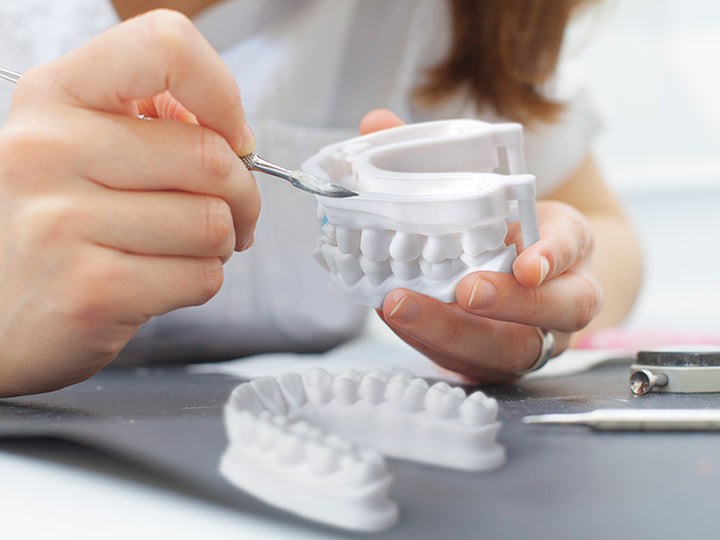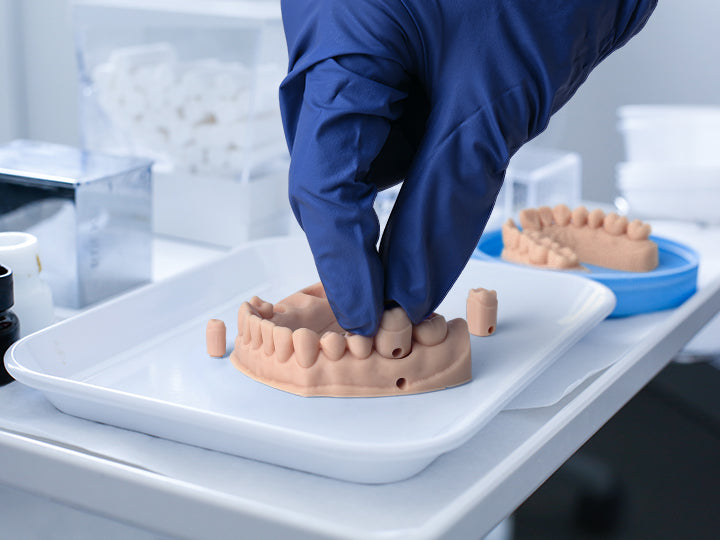3D printing has revolutionized the creation of diagnostic study models, making it faster and more cost-effective than ever before. You can now print a full-arch model for as little as $1.2 per print and have them ready to use in under 25 minutes.
To achieve this, you need to learn a few things about 3D printing. But once you're familiar with the required steps, the process isn't as complicated as it may seem. This article aims to help you master those steps.
This guide provides a step-by-step approach to 3D printing diagnostic models using the Phrozen 4K XL 2022 printer. However, it is also applicable if you're using the Phrozen 4K 2022 or Phrozen 4K XL printer.
Step 1: Scan
The first step in 3D printing surgical guides, bite splints, dental restorations (such as crowns, bridges, or veneers), or diagnostic model is to acquire digital impressions of the patient's intraoral condition.
There are two primary methods you can use to obtain these digital impressions:
- Utilizing the intraoral dental scanner to scan the patient's teeth directly. The handheld scanner can be placed directly in the patient's mouth and captures images in real time, allowing for a comprehensive digital impression of the teeth and gums.
- Scan a physical model from convention impression using a desktop scanner. This method is often used in dental practices that do not have access to an intraoral scanner or for patients who are not suitable for intraoral scanning.
Regardless of which method is used, both are equally viable as long as the resulting digital impression can be saved in .STL file format.
Step 2: Slicing
Slicing is the process of converting a 3D model into thin layers that the 3D printer will print one by one. This step also enables you to customize and adjust your print orientation, support, and resin settings to achieve the desired result.
You can utilize the Phrozen DS Slicer software to complete this step within a few minutes.
First, let's open the DS Slicer software and import your scan file.

Creating a Base
If you haven't included a base in your model design, the DS Slicer software can help you create one.
To add a base for your model, select the "Build Base" function from the sidebar. Click on Next twice, the software will automatically rotate the model, set up the feature line, and generate the base. You can also adjust the base height according to your preference or needs.
Print Orientation & Support
For diagnostic models, we recommend printing them either solid or hollow.
To print a solid model:
- Simply lay it horizontally flat on the building plate without adding any support.

To print a hollow model:
- First, we need to hollow our model. Click the "Hollow" icon on the side → choose "Through" → set the wall thickness at 3mm.
 (Note: It's essential to ensure that the wall thickness is thick enough to prevent damage to the model. We highly recommend making it at least 3mm thick)
(Note: It's essential to ensure that the wall thickness is thick enough to prevent damage to the model. We highly recommend making it at least 3mm thick)
After hollowing the model, we need to add some support at the bottom to prevent any unwanted deformations.
- Go to the "Support" function
- Select: “Model” for Model Type, “General” for its type, “Medium” for its strength, and “Medium” for its support density
- Turn off the "Auto Rotate" function
- Click "Build Support" to generate your support.

Resin Profile
We recommend using our Phrozen Dental Study Model Resin, which enables you to print very quickly at 1.5 seconds per layer when printing on 100 µm layer height and Turbo setting.
To set your resin and its parameter:
- First, go to the settings menu by clicking the gear icon (⚙) located in the top right corner. Go to "Machine" from the sidebar menu and choose which printer you will use for printing.

- After choosing your printer, go to "Print" on the sidebar menu and then select "Phrozen Dental" and "Dental Study Model" resin.

- You will also need to select the layer height that you want your model to be printed on. The lower the layer height, the higher the detail your printed object will have. However, lower layer heights require more layers to be printed, resulting in a longer printing time. We recommend printing your diagnostic models either on 50 µm or 100 µm layer heights.

- Select the parameter that best suits your printing requirements. Inside the DS Slicer software, the resin parameter has been meticulously tested by our dental technicians, so you no longer need to undergo trials and errors in dialing the resin parameter. You can select the "Stable" setting for moderate printing speed or the "Turbo" setting for faster printing speeds.

Step 3: File Transfer
Once it finishes slicing (remember to name your file afterward), the sliced file will automatically be converted into a .ZIP file format. You can save the sliced file either to a USB drive or send it directly to your printer through network sending.
To import your files via USB:
- Click "Open the Folder" and then select the file that you want to import to the USB. Make sure that the file is saved in .ZIP format.
To import your files via WiFi:
- Click "Network sending" then enter the IP address of your printer. Make sure that the IP address you enter matches the IP address of your printer.

Step 4: Printing
Start by shaking the resin well and pouring it into the vat up to half or three-quarters of its maximum capacity. Don’t forget to double-check that all the screws (two thumbs screws on the building plate & two side screws on the vat) are tightened properly.

To start printing your diagnostic models via USB:
- Plug in your USB drive to the printer.
- On the printer’s touch panel, click "Print" button.
- Then click on the USB icon at the bottom.
- Select the file print you intend to print.
- After that, a pop-up will appear. Click “Yes” to initiate the printing process.
To start printing your diagnostic models via network sending (WiFi):
- Enter the Phrozen OS interface by clicking "Open page" or by typing in the IP address of your printer.
- Go to the "PLATES" section.
- Choose the file (based on the file name) you intend to print, and click the “Print” button on your screen. The printer would then automatically start the printing process.
(To learn more on how to start printing via network sending & Phrozen OS interface, click here)
Step 5: Post-processing
Removing the printed model from the building plate
Use a metal scraper to gently apply constant pressure at the edge of the printed object until it releases from the building plate.

(Note: Avoid using excessive force as it can damage the printed objects and cause injury to our hands.)
Cleaning the printed model
After removing the printed model from the building plate, use an ultrasonic cleaner and 95% alcohol for 120 seconds to remove uncured resin on its surface. Make sure that the object has been thoroughly cleaned, then leave it in a dark place for up to 30 minutes, or use a compressed air gun to immediately dry the printed model.
Post-curing the printed model
To post-cure your printed model, utilize Phrozen post-curing stations such as Phrozen Cure, Cure Luna, and Cure Mega. You can also use other post-curing devices as long as it emit the same wavelength (405nm). Now, If you are printing your diagnostic model using Phrozen Study Model Resin, as shown in this article, then you only need to cure your model for 1 minute to achieve good mechanical properties and precision.
(Note: Different resins have different post-curing times, so make sure to always refer to the user guide of each resin to find the appropriate post-curing time)
How much you save with Phrozen Dental?
Phrozen Dental 3D Print Solution for Diagnostic Model:



